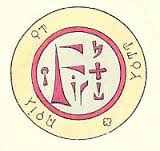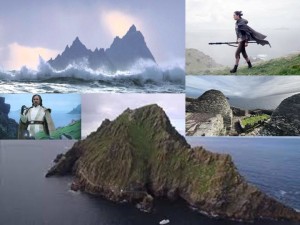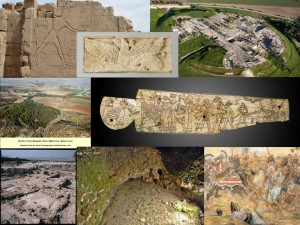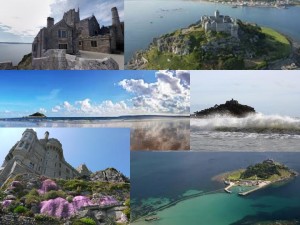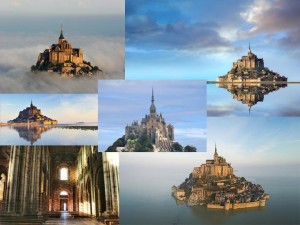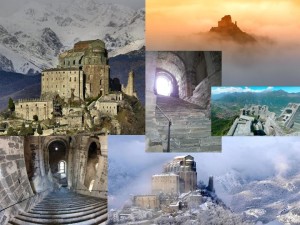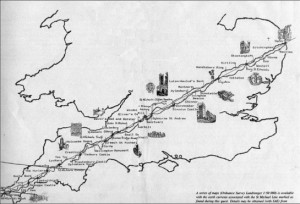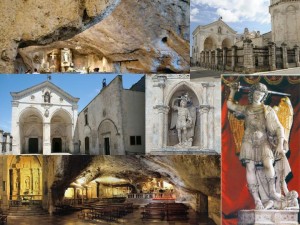
Saint Michael’s Church and Grotto at Monte Sant’Angelo in the Gargano (Italy)
As for the position on the line, Monte Sant’Angelo has an azimuth of 126* with Megiddu; its distance from Armageddon is 1970 km, while the church is directed to the north. It is difficult to calculate the exposure of the cave.
Finally, the sixth point before Armageddon is the island of Symi, just north of Rhodes, with its orthodox monastery near Panormitis, located at sea level, with a geology presumably made up of recent calcareous marine sediments.
This is the closest point to Israel (800km), with an azimuth of 125° with Megiddu, and it’s characterized by a relatively recent construction (1100th D.C.) even if the era of Saint MIchael’s vision is reported to 450 D.C.
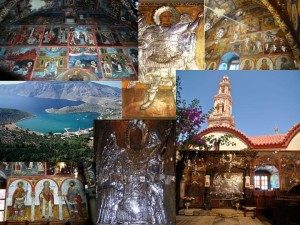
Panormitis Monastery, Symi Island (Rhodes)
After this excursus on the seven sites, there is nothing left to say but ask oneself what could be the meaning of Saint Michael’s line, highlighted below which does not appear straight on the account of the curvature of the earth, Nevertheless, this has been taken into account by a program of spherical trigonometry, verified by ArcGIS, whose application allowed to report a table containing the angular distances of the six monasteries to two places: Megiddu and Mount Carmel. They are only few kilometers distant from each other so that there is not a significant difference in the choice between them to calculate their angular distance from the six monasteries. Consequently we can assume that the end of the lineshould be in any case located in Israel.
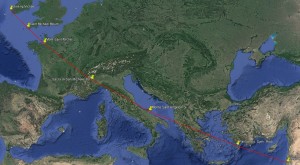
The seven points of Saint Michael’s line
| Sites |
Longitude |
Latitude |
|
azimuth to Megiddu |
azimuth to Mount Carmel |
|
|
|
|
|
|
| Mt. St. Michel |
-1,54623 |
48,62449 |
|
131,28388 |
131,13103 |
| Sacra di S. Michele |
7,34004 |
45,09637 |
|
128,34122 |
128,13917 |
| S. Michele Arcangelo |
15,95482 |
41,70807 |
|
126,37788 |
126,09608 |
| Mount Megiddo |
35,17555 |
32,58002 |
|
|
|
| Skelling Michael |
-10,53861 |
51,77222 |
|
134,10124 |
133,97814 |
| St. Michael’s Mount |
-5,47750 |
50,11583 |
|
132,63635 |
132,49874 |
| Greek Orthodox Monastery of Taxiarchis Mihail Panormitis |
27,84611 |
36,54833 |
|
125,36483 |
124,72260 |
| Mount Carmel |
35,04839 |
32,74273 |
|
From these data, several hypotheses can be made, essentially of two types.
The first could be a connection between macrocosm and microcosm. This opens up a complex astronomical chapter in which many variables can be taken into consideration, starting from the 4 Royal Stars traditionally associated with the 4 archangels, up to the solstice and equinoctial points and to other important points such as the galactic center.
Once the variables have been chosen, it is a matter of verifying- on a temporal scan which is actually rather vast – how the celestial points are configured with respect to the alignment.
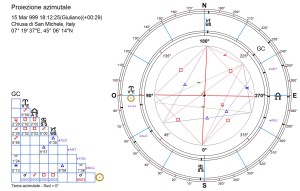
Azimuth of the 4 Royal Stars at Sacra di San Michele in 999 A.C.
In the example above we see the Sun at sunset exactly aligned to the west of the main axis of the Sacra at the spring equinox of the year 999 while Aldebaran, the star corresponding to the archangel Michael and ruling the cardinal point of the east, is located 30° from the Sun in a semisextile angle.
The simplest astronomical interpretation is that the rising Sun at the winter solstice is at 125 ° of azimuth (at 45° of latitude), therefore precisely on this line: this space-time in Michael’s and Apollo’s sacred places would become even more important because the date of December 21 is associated with Christ’s birth, the solar symbol and healer par excellence. With the Sun entering Capricorn, the new seasonal cycle starts, and the return of Light is celebrated with the beginning of the New Year. All the seven points of the line at the solstice of December 21 are enlightened by the Sol Invictus.
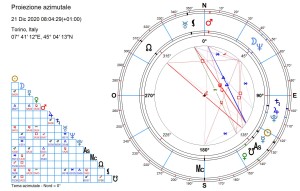
The Sun at 125 ° in azimuth rising at the winter solstice
Even without any astronomical correspondence, however, the line could be traced back to a terrestrial form with a celestial value, according to a typical Feng Shui parallelism. The forms that can be recognized are those of the sword and the cross, adding an arm as in the following drawing:
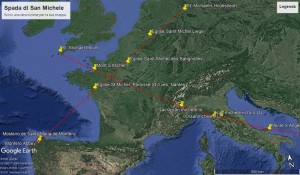
Hypothesis of double perpendicular alignment in the shape of a sword or Cross (the line of San Michele is incomplete) – – click to enlarge
In this example, the second alignment consists of the following sites: Monastery of Santa Maria de Monfero in Galicia, Nantes in Brittany, Paris, Liège in Belgium and Hildesheim in Germany. These sacred sites include four churches dedicated to St. Michael and a Marian monastery. This line would form the short side of the Cross or the hilt of Michael’s sword.
There are actually many sacred centers dedicated to the archangel Michael and therefore there are many possible geometric combinations but, remaining on the rectilinear direction with the azimuth closed to the line of the solstices, seven points are added to the canonical ones: Lucca (church of San Michele in Foro) , Florence (Orsanmichele), Perugia (church of San Michele Arcangelo) and Rome (Castel Sant’Angelo), without forgetting two less important places from an artistic-architectural point of view such as the church of San Michele in Castiglione Garfagnana and the bridge of San Michele al Serchio in the province of Lucca.
Moreover, If we should add the pairs of synchronous lines as suggested for example by Sig Lonegren, a masculine one and a feminine one, then we could also run after Saint Michael’s line along with Mary’s line not in a straight line and find their passages also in Paris Notre Dame, in Delphi (Apollo = Michael) and Athens (Athena = Mary). The terminal of the masculine yang line “Saint Michael’s line” would be Mount Armageddon, while the terminal of the sister yin line “Saint Mary’s line” would be Mount Carmel. This hypothesis is confirmed by Letizia Garozzo in her fascinating kabbalistic article on Michael the Archangel when she cites the numerological references of Mount Megiddu and Mount Carmel, 10 and 16 respectively, the sum of which gives 26, the Tetragrammaton.
Here is an example taken from “Mistery Hunters” of the two lines (Ley lines) along Saint Michael’s line in England
A subsequent study on the alignment of St. Michael in England follows the same methodology of this article and calculates its exact orientation according to the azimuths of the sites.
